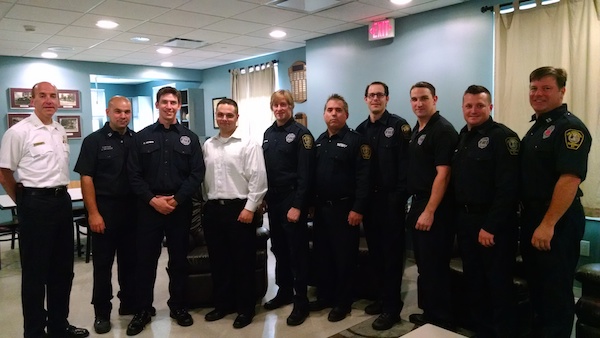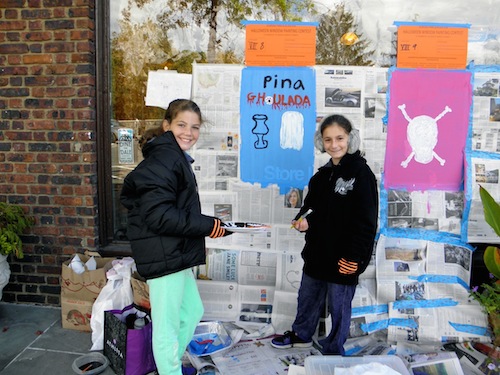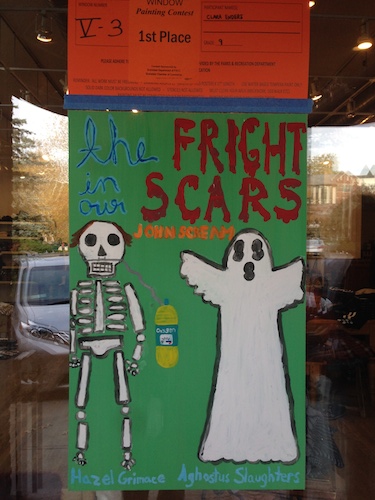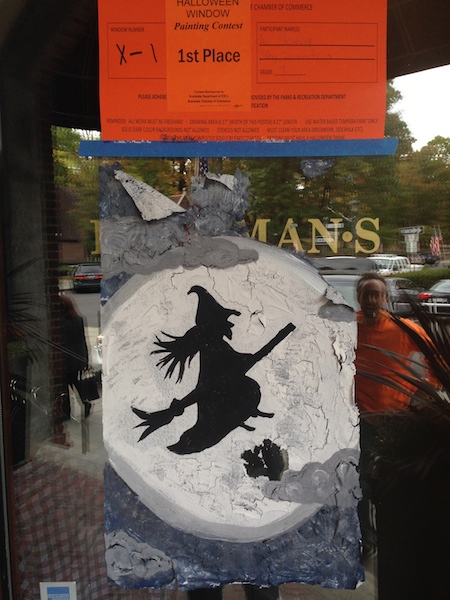Westchester Voters Go Democratic
- Details
- Written by: Joanne Wallenstein
- Hits: 4839
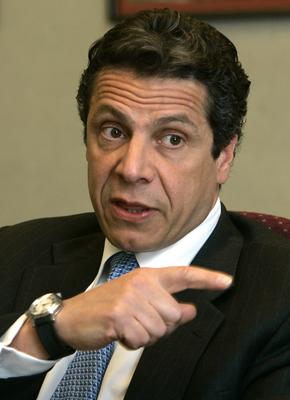 Though the Republicans dominated the national election, Westchester County Executive Rob Astorino failed in his bid to unseat popular Governor Andrew Cuomo either in his own county or statewide. The unofficial vote tally for Westchester County shows that Cuomo got 55% of the vote to Astorino's 42%. Statewide results were similar with Cuomo at 53% to Astorino's 39%. So for now Astorino will return to White Plains and focus on county issues.
Though the Republicans dominated the national election, Westchester County Executive Rob Astorino failed in his bid to unseat popular Governor Andrew Cuomo either in his own county or statewide. The unofficial vote tally for Westchester County shows that Cuomo got 55% of the vote to Astorino's 42%. Statewide results were similar with Cuomo at 53% to Astorino's 39%. So for now Astorino will return to White Plains and focus on county issues.
Cuomo faced criticism for disbanding the Moreland Commission, a group he had formed to investigate corruption. He angered some voters with mandating a comprehensive state testing program in local schools. However his campaign messaging stressed new gun control laws, balanced budgets and reduced tax increases due to the tax cap. Cuomo spent $30 million on the campaign to Astorino's $4.6 million. Speaking from Mt. Kisco Cuomo said, "We cut spending, we reduced taxes and jobs are coming back. Westchester County has the highest property taxes in the nation and I am tired of excuses from local government about why they can't make ends meet."
In his concession speech Astorino indicated that he would run again, saying, "We have not tilted at windmills – we have planted a flag and will be back to claim it. Better governing is what NY needs." Quoting John F. Kennedy he said, "Without debate, without criticism no administration and no country can succeed and no republic can survive."
Democrat incumbents for state office all fared well in Westchester County. Comptroller Thomas P. DiNapoli got 60% of the vote here and 57% statewide. Attorney General Eric Schneiderman got 59% of the vote in Westchester and 54% in NYS. Congressman Eliot Engel and State Assemblywoman Amy Paulin both ran unopposed. Commenting on her re-election, Paulin said, "I want to thank the voters in my district for their support. It has been my great pleasure to represent the people of the 88thAssembly District. Together we have accomplished so much and I look forward to continuing to work on legislation and constituent issues that matter to you and to all New Yorkers, said Paulin. "I am honored to have your trust."
Scarsdale's State Senator Andrea Stewart Cousins had a solid victory with 73% of the vote vs.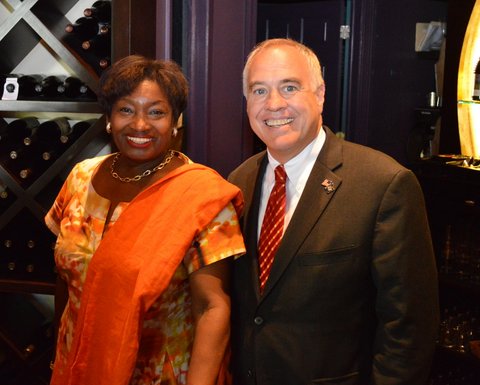 27% for her Republican challenger Robert Lopez Foti. She hoped to become the first woman to lead the majority party in the NYS Senate but her colleagues did not fare as well and the Republicans are claiming a majority of the seats in the NYS Senate. A spokesperson from her office said, "Senator Stewart-Cousins won a resounding victory in her district and thanks voters for their support."
27% for her Republican challenger Robert Lopez Foti. She hoped to become the first woman to lead the majority party in the NYS Senate but her colleagues did not fare as well and the Republicans are claiming a majority of the seats in the NYS Senate. A spokesperson from her office said, "Senator Stewart-Cousins won a resounding victory in her district and thanks voters for their support."
Scarsdale's own Acting Village Justice Arlene Katz won her bid for Family Court Judge with an impressive 137,265 votes. Commenting on the results, Katz said, "It has been a great honor to serve as Acting Village Justice in Scarsdale for almost 19 years. I am now deeply honored to have been elected to the position of Family Court Judge in Westchester County. Decisions made in Family Court can have longstanding consequences and often affect every aspect of the lives of families and children every single day. I am committed to making a difference and ensuring all those who appear before me receive the services, guidance and protection they need and deserve."
All three ballot propositions passed in both Westchester and in NYS. The Scarsdale Schools will benefit from the Smart Schools Bond Act and is slated to receive $445,000 for classroom technology, high speed internet and tech smart security features from the $2 billion bond.
Cable Commission Proposes Improvements for the Scarsdale Cable Channel
- Details
- Written by: Joanne Wallenstein
- Hits: 5638
 In the wake of a proposal from the Scarsdale Village Manager's office to consolidate the operation of the Scarsdale Cable Channel with New Rochelle, the Scarsdale Cable Commission presented their own proposal to modernize the village's cable operations and maintain local control.
In the wake of a proposal from the Scarsdale Village Manager's office to consolidate the operation of the Scarsdale Cable Channel with New Rochelle, the Scarsdale Cable Commission presented their own proposal to modernize the village's cable operations and maintain local control.
Representing the Cable Commission, Lorayne Fiorello explained the proposed plan to the Scarsdale Board of Trustees on Tuesday October 28, saying that the commission studied the issue, reviewed new technologies on the market and looked into how other municipalities are managing their public access channels. She stressed that this new program would cost no more than the $70,350 currently allocated in the Village Budget. These funds are provided by Verizon and Cablevision and now go into the Village's general fund.
The commission recommended hiring a new Senior Cable Commission Coordinator to work 20 hours per week and interviewed many candidates. In addition they recommended that the village continue to use part-time camera operators and an assistant Cable Television Coordinator.
The commission proposed to expand programming beyond Village Board Meetings and broadcast community events such as the Memorial Day Parade, annual fireworks, Halloween Window Painting, meetings of the Scarsdale Forum and the annual library book sale. They proposed installing fixed cameras in the Scott Room at Scarsdale Library to broadcast some of the special events that occur there.
Village organizations would be permitted to publicize their activities by making their own Public Service Announcements with the assistance of the Village's cable team. These PSA's could be aired on the channel in between programming. Residents could also sign up to produce and air their own shows on the channel. By law all residents have the right to air their own programming on the site though no one is currently doing so.
The commission also recommended upgrading the equipment using PEG funds (Public, Educational and Government). Using new technology from Tightrope Media and Swagit, all programming could be offered on the internet as well as on television. Streaming video equipment would provide residents access to live and archived programming.
Fiorello summed up by saying, "We have done research. We have experience in this field and we think we can make this one of the top flight stations in Westchester."
After some discussion, the Board then went into executive session to discuss the personnel portion of the proposal.
At the Village Board meeting that followed that same night, Bob Harrison continued to urge the Board to require the Planning Board to deliberate in public rather than behind closed doors. He mentioned that he attended a meeting of the Planning Board where they considered a subdivision at 15 Circle Road and said that none of the attendees at the meeting were able to hear the discussion on the issue.
In other business, the board granted a license agreement to Alan and Deborah Annex of 7 Park Road to construct steps from the street to their driveway in the Village right of way.
The board also voted unanimously to refer several proposed changed to the Village Zoning Code to the Planning Board for review and comment. The proposed amendments were not distributed.
Mayhem Haunted House - Final Weekend
- Details
- Written by: Joanne Wallenstein
- Hits: 4347

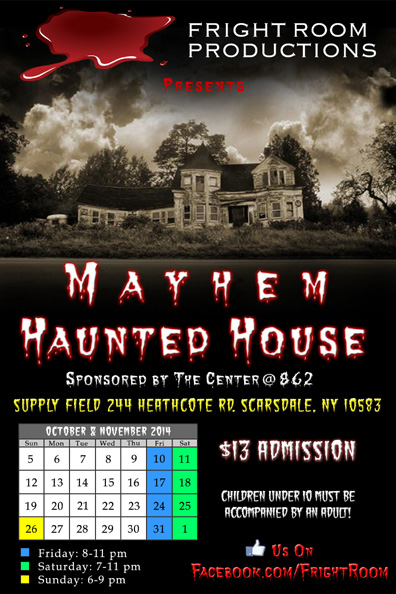
Announcing the Winners of the 2014 Window Painting Contest
- Details
- Written by: Joanne Wallenstein
- Hits: 10014
 There's no end of talent in Scarsdale, as demonstrated at the 63rd annual Halloween Window Painting Contest. This year's Grand Prize went to Mary Cecil for her masterpiece, Ghoul with the Pearl Earring, now on display at LF in the Village. The contest began in 1952 and the Recreation Department believes that Scarsdale was the first Village to run such a contest.
There's no end of talent in Scarsdale, as demonstrated at the 63rd annual Halloween Window Painting Contest. This year's Grand Prize went to Mary Cecil for her masterpiece, Ghoul with the Pearl Earring, now on display at LF in the Village. The contest began in 1952 and the Recreation Department believes that Scarsdale was the first Village to run such a contest.
There were a total of 149 individual entries, 117 team entries and 106 parent/child entries for a total of 595 participants. It was fun and challenging for parents and children who quickly learned that there's even an art to painting the window background. Awards and honorable mentions were given out by a team of volunteers judges including current and former Scarsdale residents, many who were former window painters themselves.
An official awards ceremony will take place on Thursday November 6th at 7:30 pm in the auditorium at the Quaker Ridge School. Congrats to all the painters:
Here's the list of winners and a photo gallery of young painters in town by local photographer Trudy Zohn:
Group # 1
1ST Harley Koch I-30 La Renaissance
2ND Anna Henry I-23 Parkway Coffee Shop
3RD William Gettinger I-27 Scarsdale Eye Care Center
MOST COMICAL Raymond Donovan I-47 DeCicco's
Honorable Mentions: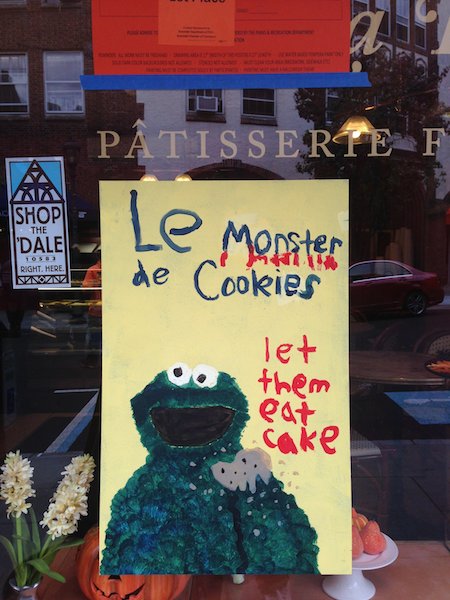
Taylor Mann I-4 Lange's Deli
Zachary Kristol I-5 Lange's Deli
Danielle Barro I-11 Great Stuff
Fiona Kantor I-33 Trapp Opticians
Samantha Loeser I-43 Sam Lehr
Group #2
1ST Liu, Olivia II-39 Remax
2ND Cavalier, Andrew II-13 Scarsdale Hardware Company
3RD Litofsky, Camryn II-37 Remax
MOST COMICAL Fujii, Miho II-11 Henry's Barber Shop
Honorable Mentions:
Hyman, Benjamin II-4 Coldwell Banker
Nova, Henry II-12 Scarsdale Hardware Company
Fischman, Miles II-24 Authentic Pilates
Kolodner, Emily II-30 Authentic Pilates
Group #3
1ST Wise, Chloe III-25 Kumon
2ND Schwarz, Jordan III-1 Big Top
3RD Kantor, Jolie III-5 Big Top
MOST COMICAL Perl, Alexandra III-9 Big Top
Honorable Mentions:
Knispel, Matthew III-3 Big Top
Breakstone, Leah III-17 Jade Spoon
Stefanou, Anastasia III-26 Kumon
Rechtschaffen, Nathaniel III-35 Amore Pizza
Group #4
1ST Du, Lucy IV-14 Gingerbread Kidz
2ND Glik, Amanda IV-7 Prudential
3RD Cecil, Jack IV-10 Gingerbread Kidz
MOST COMICAL Bailey, Madeleine IV-6 Pamela Robbins
Honorable Mentions:
Segale, Carla IV-1 Wilson & Sons
Mahoney, Lynne IV-3 Wilson & Sons
Cecil, Lucy IV-9 Gingerbread Kidz
Kantor, Margaret IV-13 Gingerbread Kidz
Group #5
1ST Enders, Clara V-3 LF Stores
2ND Bochner, Amy V-1 Danielle Trissi
3RD Cooper, Emma V-2 LF Stores
Group # 6
1ST Griffin Miller Jake Lippmann VI-14 Chef's Table
2ND Luciana Serrano Jade Kraut VI-18 Neil's
3RD Drew Frank Billie Eichel VI-7 Platinum Drive Realty
MOST COMICAL Lana Weiser Maya Regenstreif VI-16 Eye Q Optometrist
Honorable Mentions:
Claire Matula-Osterman, Deanna Matula-Osterman VI-1 Bagel Power
Drew Siegel Abby Etra VI-3 Bagel Power
Group #7
Ellie Bowen Sophie Brenner VII-5 Chase Bank
Madeline Stein Isabelle GoldbanVII-2 Chase Bank
Anna Feldstein Carly GellesVII-18 Vintology Wine & Spirits
Ashley Katzenberg Sydney Seslowe VII-27 Chase Bank
Honorable Mentions:
Eshan Agarwal Jackson Fielding VII-7 Chase Bank
Dani Scheiner Chelsea Berson VII-20 Vintology Wine & Spirits
Group #8
1ST Jeffrey Morse Jayden Bharara VIII-14 Chase Bank
2ND Samantha Kefer Sophia Sipe VIII-20 Chase Bank
3RD Danielle Kohn Emily Messerle VIII-16 Chase Bank
MOST COMICAL Justine Karp Anna Forest VIII-46 Houlihan Lawrence
Honorable Mentions:
Deven Mehta Jonah Rosenstein VIII-1 Heathcote Tailors
Julian Glantz Will Reed VIII-5 La Dentelliere
Sydney Frank Marin Yearley VIII-9 Zachy's Liquor Store
Avery Bensche Nozomi Akita VIII-15 Chase Bank
Emily Simons Blake Goodman VIII-18 Chase Bank
Madison Rosenberg Riley Zachem VIII-19 Chase Bank
Jane Schmelkin Emma Hochberg VIII-22 Chase Bank
Jordan Cascade Ethan Weismer VIII-24 Dunkin' Donuts Juliette Silk Emily Shawn VIII-28 Little Thai Kitchen
Juliette Silk Emily Shawn VIII-28 Little Thai Kitchen
Samantha Menell Ava Thomas VIII-44 Part II Salon
Jonah Miller Zachary Loeser VIII-45 Merle Norman Cosmetics
Group #9
1ST Anika Agarwal Adina Mistry IX-4 Bank of America
2ND Caroline Goldstein Sanjana Bhatnagar IX-13 Embassy Cleaners
3RD Alison Rothberg Sara Frankenthaler IX-12 Embassy Cleaners
MOST COMICAL Rachel Meiselman Jocelyn Lewis IX-1 Bank of America
Honorable Mentions:
Jordana Love Jessica Solodar IX-2 Bank of America
Jennifer Farfel Evan Shire IX-10 Bank of America
Molly Grand Olivia Boccia IX-17 Embassy Cleaners
Sophie Grand Isabella Lelis IX-18 Embassy Cleaners
Group #10
1ST Abigail Rosenstein, Ariel Stonberg X-1 Rothman's
Village Board Gives Greenlight to Demolish Greenacres Home, Awards Medal for Heroism and Appoints Architect to Oversee Construction at 2-4 Weaver Street
- Details
- Written by: Joanne Wallenstein
- Hits: 13039
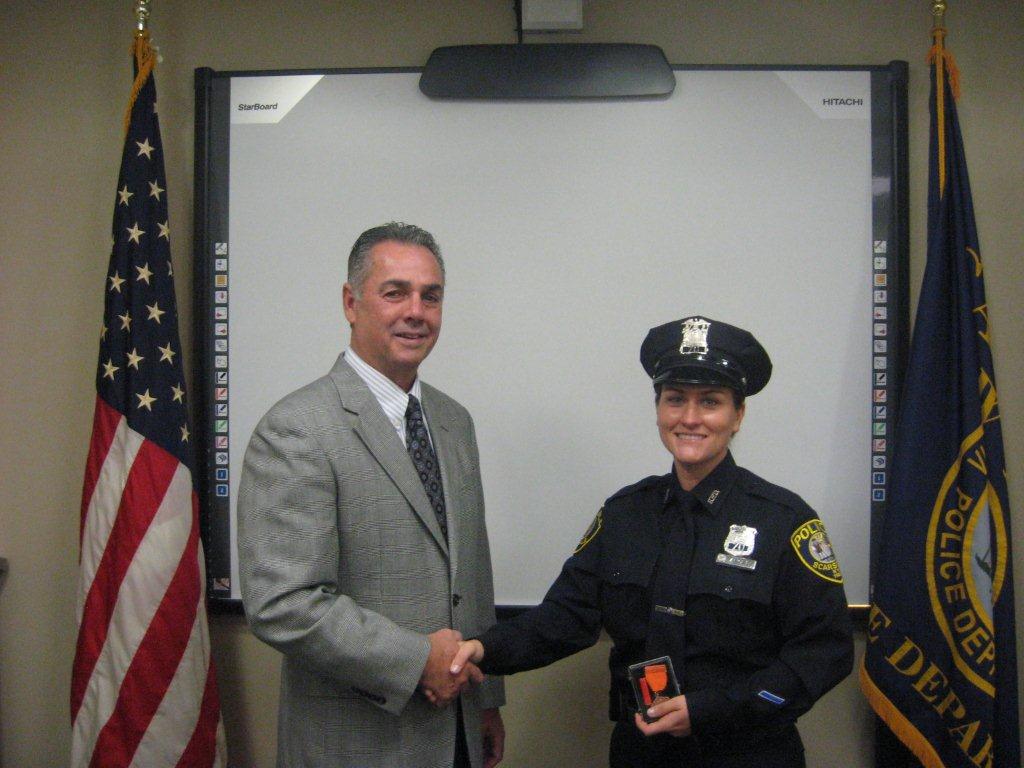 Heroism, historic preservation, lights and building issues were all on the agenda at a busy meeting of the Scarsdale Village Board meeting on Tuesday night October 14.
Heroism, historic preservation, lights and building issues were all on the agenda at a busy meeting of the Scarsdale Village Board meeting on Tuesday night October 14.
Police Officer Patricia Arcesi was awarded an Exceptional Duty Medal for her work in the arrest of an armed man who was fleeing a burglary on Walworth Avenue in July 2013. Arcesi came upon a white SUV with North Carolina stopped on Mamaroneck Road at 10:35 pm blocking traffic. She approached the driver and while she was speaking to him she received a hotline message from the city of White Plains which said they were looking for a car that matched the SUV's description in connection with an interrupted burglary on Walworth Avenue.
As she listened to the dispatch she saw the driver of the car become anxious and agitated and move his hands around the car despite the fact that she told him to keep his hands on the steering wheel. For her own safety she drew her weapon on the driver until back-up arrived. When police got the man out of the car they found what appeared to be a black semi automatic handgun which was later determined to be a pellet gun replica in the driver's side door of the car. The suspect also had a Rye PBA surgeon badge, and Eastchester EMS Medical Director badge and other police paraphernalia along with a vanity license plate that said New York Police.
Arcesi was recognized for remaining "alert, calm and in control in the face of a volatile situation that could have resulted in the use of extreme force." The suspect was arrested for criminal possession of a weapon 4th degree and unlicensed operation of a vehicle.
In the public comments portion of the meeting, Adrienne Price of Herkimer Road took her troubles directly to the Board on Tuesday night, explaining that the developer of a house next door to her house had changed the topography of the site. According to Price, the Board of Architectural Review approved plans for the new home that provided that the level of the backyard remain the same. However, Price reports that the builder added four feet to the height of the backyard, making a visual impact on her property. Despite repeated calls and meetings with the Village Engineer she said nothing had been done. In a rather heated exchange, Village Manager Al Gatta defended the Building Department and Village Engineer saying that the Village has asked the developer for a new storm drainage plan and that the site can't be "brought into compliance while it is under construction." He assured her that the C of O would not be granted until the site was in compliance with the plans.
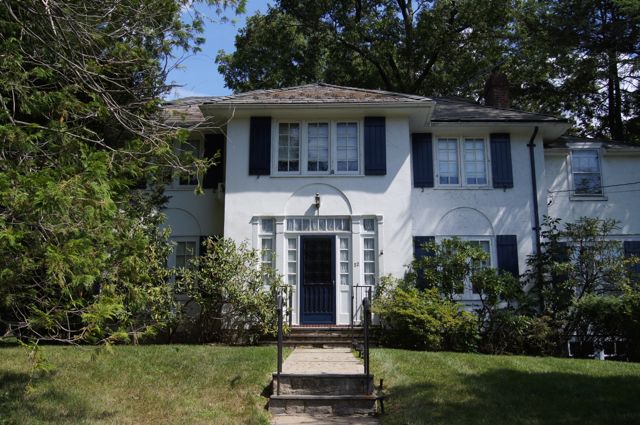 In other land use news, the Board of Trustees announced their findings following a special meeting on September 22 to consider the fate of 22 Montrose Road (pictured above). The Committee for Historic Preservation had barred the demolition of the home after their May 20, 2014 meeting where they found it had significant historical importance. The owner appealed the decision to the BAR who voted in favor of permitting the demolition by a vote of 3-2. However since that was not a majority vote since others were absent this vote resulted in a default denial.
In other land use news, the Board of Trustees announced their findings following a special meeting on September 22 to consider the fate of 22 Montrose Road (pictured above). The Committee for Historic Preservation had barred the demolition of the home after their May 20, 2014 meeting where they found it had significant historical importance. The owner appealed the decision to the BAR who voted in favor of permitting the demolition by a vote of 3-2. However since that was not a majority vote since others were absent this vote resulted in a default denial.
The decision was then appealed to the Board of Trustees that has different criteria for preservation. After consideration of their four criteria the board found that the house should not be preserved because it "represents the face of the neighborhood," and granted permission to owner Seymour Wald and the prospective buyer Steven Silberstein to tear it down.
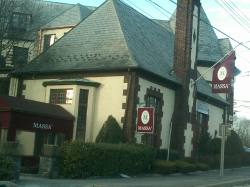 Turning to the development of a 14 unit residential building at the site of the Heathcote Tavern and parking lot, the Board approved a resolution allocating $39,000 to retain architect David A Barbuti to review the building plans and inspect for compliance with the plans during construction. The independent monitor will advise the Village on the consistency of the construction documents with the approved plans to ensure that both the interior and exterior are built to match what was approved by the various Village boards.
Turning to the development of a 14 unit residential building at the site of the Heathcote Tavern and parking lot, the Board approved a resolution allocating $39,000 to retain architect David A Barbuti to review the building plans and inspect for compliance with the plans during construction. The independent monitor will advise the Village on the consistency of the construction documents with the approved plans to ensure that both the interior and exterior are built to match what was approved by the various Village boards.
Road closure: Fenimore Road will be closed from Fox Meadow Road to Oak Way on Monday October 20 and Tuesday October 21 from 9:30 am to 3 pm. The closure will allow for an excavation to measure a water main so that the Village can purchase a line stop. The Village needs an exact measurement to replace a critical valve at the intersection. Therefore, Fenimore Road will be closed for almost six hours a day on Monday and Tuesday
Village Election: The Board authorized the General Village election for March 18, 2015.
Portable Lights for Youth Football: The Board approved a resolution to permit the use of temporary lights at Supply Field for Youth Recreational Football from October 15 through November 21 for three days a week until 7:30 pm. Use of the portable lights has been donated by a Scarsdale resident and those same light will also be utilized by the Scarsdale Teen Center for their haunted house event for nine nights in October.
Peter C. Alderman Foundation: The board received a letter of thanks from the Peter C. Alderman Foundation for the use of village streets and the Fox Meadow School to hold its annual fundraising walk to celebrate Peter's life. Peter died 13 years ago on 9/11 and the even raises fund for the foundation's mission which is to heal the emotional wounds of war-affected societies around the world.
Fire Chief Thomas Cain sent us the photo below of the swearing in of firefighter Michael Owens on October 15, 2014. Owens transferred from the Town of Mamaroneck Fire Department where he has been employed since 2013. While with Mamaroneck Owens completed an intensive seventeen-week training program at the Westchester County Career Fire Academy at the County Fire Training Center in Valhalla, NY and is already a Nationally Certified Level II firefighter. Owens is from Valhalla and is single. Several on-duty Scarsdale firefighters attended the ceremony as well.
